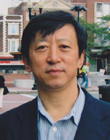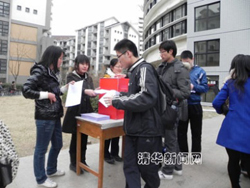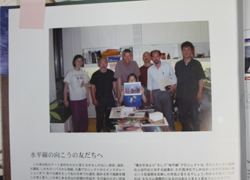Top>Opinion>Considering the Starting Point of Japan-China Relations from the Perspective of Disasters
 Index
Index

Li Tingjiang [Profile]
Considering the Starting Point of Japan-China Relations from the Perspective of Disasters
Li Tingjiang
Professor, Faculty of Law, and President, Research Center for Development of Japan-China Relations, Chuo University
Areas of specialization: History of East Asian International Relations, History of Modern Japan-China Relations
In Memory of Victims
The other day, I visited Fukushima, Sendai, and Iwaki to see the afflicted areas where the unprecedented earthquake and tsunamis deprived victims of their houses, workplaces, and many precious lives, and where people are still forced to struggle with the nuclear power plant accident and the damage from harmful rumors. Observing such a situation, I was struck by the enormity of the damage and paid my deepest condolences to those who were killed in the disaster.
1) Japan-China cooperation at the time of disaster
To begin with, China also has many earthquakes. The Tangshan Earthquake in 1976 killed more than 240 thousand people. When I participated in relief activities in Tangshan, I heard that four Japanese engineers were among the victims at the Douhe Power Plant adjacent to my camp. On March 11 of this year, I was in Beijing preparing a seminar on East Asian Community hosted by the Research Center for Japanese Studies at Tsinghua University. Immediately after the earthquake, students started activities to raise money on the university campus, and along with one hundred fellow scholars, I called on all Chinese to assist afflicted Japan through a Chinese newspaper. The media reported extensively on Mr. Sato, who gave his life in the process of saving Chinese trainees, which created a deep impression on the entire nation of China. At that time, I definitely witnessed a scene I have never seen before, where everyone was thinking desperately about what he or she can do for the afflicted areas damaged by the earthquake, tsunamis, and the nuclear plant. On May 21, when Chinese Premier Wen Jiabao visited Japan, he said: "confronting a natural disaster, human beings are a natural community with a common destiny. We must remember that the government and nation of Japan gave strong assistance to China when we suffered a great disaster." This message can be regarded as exemplifying the feeling of many ordinary Chinese people.

2) World-famous Cai Guo-Qiang and Iwaki
A friend of mine introduced to me Mr. Tadashige Shiga in Iwaki, who is the leader of the Seven Samurais of Iwaki, who have cooperated with and supported world-famous master Cai Guo-Qiang, the designer of fireworks for the Beijing Olympics, since the time when he was still unknown. Born in Quanzhou, Fujian Province, Mr. Cai graduated from Department of Stage Design at the Shanghai Theater Academy in 1985, and came to Japan the next year with his wife. He first lived in a four-and-a-half-mat room in Tokyo, and then moved to Iwaki, where he spent as long as seven years until he moved to New York in 1995. Now travelling around the world, he says that people in Iwaki recognized him and his wife as humans. When Japan-China relations were strained due to historical problems, a Chinese reporter asked him how he was able to make friends with Japanese. He answered that he could begin a friendship with them because he was simply an artist and people in Iwaki were ordinary people. Mr. Shiga told me that Mr. Cai has worried about Iwaki after the earthquake, often called him, and given support in various ways. This story about Mr. Cai and the people of Iwaki beautifully represents the ideal grass-roots exchange between Japanese and Chinese. I believe that the words of Mr. Cai, "I cultivate works on this land, have a dialogue with the universe from here, and create a story of the time with people here," speak to the root of humans, art, and the universe.

3) As the starting point of Japan-China relations
Having come to Japan in 1982 and specializing in the history of modern Japan-China relations, I was often disappointed by the reality that both nations never improved their images of one another. Since the Meiji period, Japan had been under the influence of De-Asianization [Datsu-A Ron] authored by Yukichi Fukuzawa during rapid modernization, had been dominated by the military, had gone the way of invading Asian nations, and as a result, had caused considerable damage to China, the Korean Peninsula, and many other countries. On the other hand, both nations have also shared the idea of solidarity aiming to free Asia ranging from "Asia is one," by Tenshin Okakura, to the Pan-Asianism of Sun Yat-sen. This bright as well as dark history represents the inextricable geographical, cultural, and economic ties between Japan and China, has and it has also complicated their relations. I suppose that the difficulty of talking about Japan and China is rooted in how to recognize such history. When Japan and China normalized their diplomatic relations in 1972, Yoshimi Takeuchi pointed out regarding the future of Japan and China that "development would be impossible without creativity." Immediately after that, however, he added that, "creativity would be impossible without development." I recently realized that this is the very starting point for mutual recognition between Japan and China.
4) Japanese youth can soar in the world
Today, both Japan and China are at a centurial turning point. While experiencing remarkable economic development, China faces structural challenges inside and outside the country during this difficult and pivotal time. On the other hand, Japan can be said to have entered the third period of opening the country, triggered by the great earthquake disaster. Such deepening interdependence between Japan and China is likely to be one characteristic of the twenty-first century. What should human beings learn from natural disasters? What should Japan and China learn from history? The answer is simple: valuing life and having reverence for all things. More and more students are recently interested in China, and the number of seminar students who wish to study in China is also increasing-a most welcome trend. I am now enjoying my work in the classroom, believing that young Japanese people will jump onto the world stage one after another in the near future, taking advantage of the opportunity to experience living in China, just as Mr. Cai Guo-Qiang did.
- Li Tingjiang
Professor, Faculty of Law, and President, Research Center for Development of Japan-China Relations, Chuo University
Areas of specialization: History of East Asian International Relations, History of Modern Japan-China Relations Professor Li is a Professor, Faculty of Law, and President, Research Center for Development of Japan-China Relations, Chuo University.
He was born in Shenyang, China, in 1954, and graduated from Tsinghua University in 1977.
He came to Japan in 1982 after working for the Institute of World Politics and then the Institute of Japanese Studies, Chinese Academy of Social Sciences.
He graduated from the doctoral program of International Relations, University of Tokyo in 1988 (Ph.D.).
He has been a Professor, Faculty of Law, Chuo University, in 2000 after assuming the positions of Associate Professor and Professor, Faculty of International Relations, Asia University.
He was a visiting fellow at the Reischauer Institute of Japanese Studies, Harvard University, from 1992 to 93.
He has doubled as Wei Lun Special-Appointed Professor, Tsinghua University, and a board member and vice director, Research Center for Japanese Studies, Tsinghua University, since 2008.
Professor Li's current research interest is exploring issues and concepts of the 21st-century relationship between Japan and China through the examination of interaction between change in the international environment surrounding East Asia and endogenous transition in the same region from the historical perspective of modern Japan-China relations.
His major publications include Japanese Business Community and Modern China [Nippon Zaikai to Kindai Chugoku] (Ochanomizu Shobo, 2003); and Atsumaro Konoe and Chinese Important People at the End of the Qing Dynasty [Konoe Atsumaro to Shin-Matsu Chugoku Yojin] (Hara Shobo, 2004).
- Research Activities as a Member of Research Fellowship for Young Scientists (DC1), Japan Society for the Promotion of Science (JSPS) Shuma Tsurumi
- Important Factors for Innovation in Payment Services Nobuhiko Sugiura
- Beyond the Concepts of Fellow Citizens and Foreigners— To Achieve SDGs Goal 10 “Reduce Inequality Within and Among Countries” Rika Lee
- Diary of Struggles in Cambodia Fumie Fukuoka
- How Can We Measure Learning Ability?
—Analysis of a Competency Self-Assessment Questionnaire— Yu Saito / Yoko Neha - The Making of the Movie Kirakira Megane








